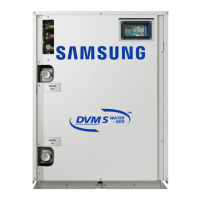38_ installing the unit
Item Unit Standard
Density g/cm
3
0.048~0.096
Dimension change route by heat % -5 or less
Water absorption rate g/cm
3
0.005 or less
Thermal conductivity kcal/m·h·˚C 0.032 or less
Moisture transpiration factor ng/(m²·s·Pa) 15 or less
Moisture transpiration grade g/(m²·24h) 15 or less
Formaldehyde dispersion mg/L -
Oxygen rate % 25 or less
Insulation
Install the insulation
to be overlapped
Indoor unit
Insulation
Gas side pipe
Liquid side pipe
Indoor
unit
Clamp
installing the unit
INSULATING THE REFRIGERANT PIPE
Insulating the refrigerant
• You must check if there is a gas leak before completing all the installation process.
• Use EPDM insulation which meets the following condition.
Selecting the insulation of the refrigerant pipe
• Insulate the gas pipe and liquid pipe by referring to the thickness of insulator for each pipe size.
• The standard condition is 30°C, less than humidity 85%. If the condition is in high humidity, use
one grade thicker.
Insulating the refrigerant pipe
• Be sure to insulate the refrigerant pipe, joints and connections with class ‘o’ material.
• If you insulate the pipes, the condensed water does not fall from the pipes and the capacity
of the air conditioner is improved.
• Check if there are any insulation cracks on the bent pipe.
Pipe Pipe size (mm)
Insulator(Cooling, Heating)
Remarks
Standard
[30°C, 85%]
High humidity
[30 °C, 85% or more]
EPDM, NBR
Liquid pipe
Ø6.35~Ø9.52
9t
Heat resisting
temperature is more
than 120°C
Ø12.70~Ø50.80
13t
Gas pipe
Ø6.35
13t 19t
Ø9.52
19t
25t
Ø12.70
Ø15.88
Ø19.05
Ø22.23
Ø25.40
Ø28.58
32t
Ø31.75
Ø38.10
Ø44.45
Ø50.80
25t 38t
DVM PLUS3 HR_IM_E_32805-2.indd 38 2011-11-11 오후 4:18:29

